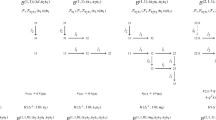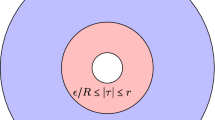Abstract
It was conjectured in the recent article by Eastwood and Isaev that all absolute classical invariants of forms of degree \(m\ge 3\) on \({\mathbb C}^n\) can be extracted, in a canonical way, from those of forms of degree \(n(m-2)\) by means of assigning every form with non-vanishing discriminant the so-called associated form. This surprising conjecture was confirmed for binary forms of degree \(m \le 6\) and ternary cubics. In the present paper, we settle the conjecture in full generality. In addition, we propose a stronger version of this statement and obtain evidence supporting it.
Similar content being viewed by others
References
Bass, H.: On the ubiquity of Gorenstein rings. Math. Z. 82, 8–28 (1963)
Dieudonné, J.A., Carrell, J.B.: Invariant theory, old and new. Adv. Math. 4, 1–80 (1970)
Eastwood, M.G.: Moduli of isolated hypersurface singularities. Asian J. Math. 8, 305–313 (2004)
Eastwood, M.G., Isaev, A.V.: Extracting invariants of isolated hypersurface singularities from their moduli algebras. Math. Ann. 356, 73–98 (2013)
Elias, J., Rossi, M.E.: Isomorphism classes of short Gorenstein local rings via Macaulay’s inverse system. Trans. Am. Math. Soc. 364, 4589–4604 (2012)
Elliott, E.B.: An Introduction to the Algebra of Quantics. Oxford University Press, Oxford (1895)
Emsalem, J.: Géométrie des points épais. Bull. Soc. Math. France 106, 399–416 (1978)
Fels, G., Kaup, W.: Nilpotent algebras and affinely homogeneous surfaces. Math. Ann. 353, 1315–1350 (2012)
Gelfand, I.M., Kapranov, M.M., Zelevinsky, A.V.: Discriminants, Resultants and Multidimensional Determinants, Modern Birkhäuser Classics. Birkhüser Boston Inc, Boston (2008)
Grace, J. H., Young, A.: The Algebra of Invariants. Cambridge Library Collection, Cambridge University Press, Cambridge (2010) (reprint of the 1903 original)
Hertling, C.: Frobenius Manifolds and Moduli Spaces for Singularities, Cambridge Tracts in Mathematics 151. Cambridge University Press, Cambridge (2002)
Hilbert, D.: Ueber die Theorie der algebraischen Formen. Math. Ann. 36, 473–534 (1890)
Huneke, C.: Hyman Bass and ubiquity: Gorenstein rings. In: Algebra, \(K\)-theory, Groups, and Education, New York, 1997. Contemp. Math. 243, Amer. Math. Soc. Providence, RI, pp. 55–78 (1999)
Kung, J.P.S.: Canonical forms of binary forms: variations on a theme of Sylvester. In: Invariant Theory and Tableaux, Minneapolis, 1988. IMA Vol. Math. Appl. 19. Springer, New York, pp. 46–58 (1990)
Mather, J., Yau, S.S.-T.: Classification of isolated hypersurface singularities by their moduli algebras. Invent. Math. 69, 243–251 (1982)
Mukai, S.: An Introduction to Invariants and Moduli, Cambridge Studies in Advanced Mathematics 81. Cambridge University Press, Cambridge (2003)
Mumford, D.: Geometric Invariant Theory, Ergebnisse der Mathematik und ihrer Grenzgebiete, Neue Folge, vol. 34. Springer, Berlin (1965)
Nagata, M.: Invariants of a group in an affine ring. J. Math. Kyoto Univ. 3, 369–377 (1963/1964)
Olver, P.: Classical Invariant Theory, London Mathematical Society Student Texts 44. Cambridge University Press, Cambridge (1999)
Saito, K.: Einfach-elliptische Singularitäten. Invent. Math. 23, 289–325 (1974)
Sharpe, D.W., Vámos, P.: Injective Modules, Cambridge Tracts in Mathematics and Mathematical Physics 62. Cambridge University Press, London, New York (1972)
Shoshitaishvili, A.N.: Functions with isomorphic Jacobian ideals. Funct. Anal. Appl. 10, 128–133 (1976)
Sylvester, J.J.: Tables of generating functions and groundforms for the binary quantics of the first ten orders. Am. J. Math. 2, 223–251 (1879) (also The Collected Memorial Papers 3, pp 283–311, Cambridge University Press, Cambridge, 1909)
Tauvel, P., Yu, R.W.T.: Lie Algebras and Algebraic Groups, Springer Monographs in Mathematics. Springer, Berlin (2005)
Watanabe, J.: The Dilworth number of Artin Gorenstein rings. Adv. Math. 76, 194–199 (1989)
Acknowledgments
This work is supported by the Australian Research Council.
Author information
Authors and Affiliations
Corresponding author
Rights and permissions
About this article
Cite this article
Alper, J., Isaev, A. Associated forms in classical invariant theory and their applications to hypersurface singularities. Math. Ann. 360, 799–823 (2014). https://doi.org/10.1007/s00208-014-1054-2
Received:
Revised:
Published:
Issue Date:
DOI: https://doi.org/10.1007/s00208-014-1054-2




